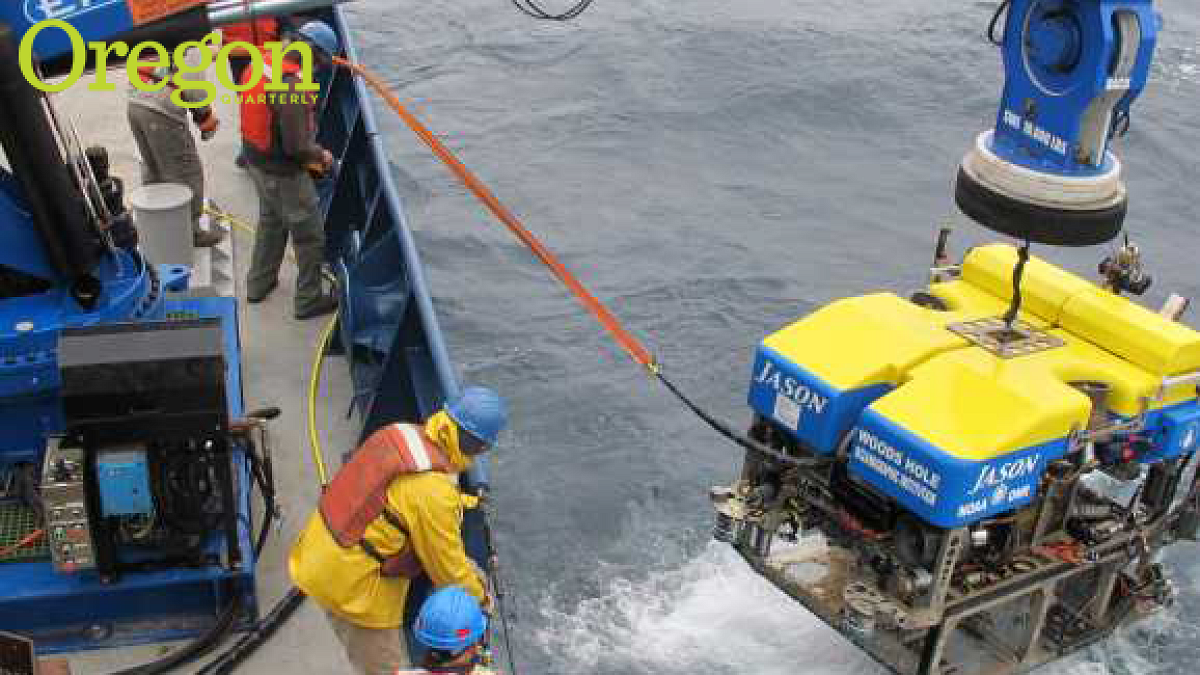University of Oregon geophysicist Dean Livelybrooks, MS '83, PhD '90, and a team of researchers and students sailed from Astoria aboard the research vessel Atlantis this summer, recovering earthquake-monitoring equipment off the ocean floor along the Cascadia Subduction Zone. Tracking activity in this area is key to scientists understanding the potential for cataclysmic earthquakes and ensuing tsunamis that could devastate large areas of the Northwest.
The UO's communications specialist Matt Cooper traveled with the researchers and filed daily dispatches—two of which are included here.
On the Pacific, Day 6:
Crunch time
The fog that rolled in June 30 is an unwelcome reminder that our window of opportunity is closing.
We're at the southern end of our trip—just off the coast of northern California—and below us are clusters of seismometers that are recording vibrations in a very sensitive area of the Cascadia Subduction Zone.
Sixteen of the monitors—more than half of the total array to be collected on this voyage—are to be plucked up from this area in the next 36 hours. That's how long we have before winds are predicted to rise, at which point the sea could get too rough for recovery of equipment.
It can take hours to recover a single seismometer, especially if the job calls for an underwater excursion by Jason, our remotely operated vehicle (ROV). That's a difficult job that requires multiple teams working in unison.
"This is the start of a busy period for us—every three hours, boom-boom-boom, we're going after seismometers," Livelybrooks said, as he watched one of the monitors get lifted on board. "Tuesday we're going to have some seas banging underneath us, so it's going to get tricky."
Sleep becomes the critical concern for everyone involved. Livelybrooks and Anne Trehu, a seismologist at Oregon State University, are calling the shots as the lead scientists on the voyage, making sure to balance the need to collect data with the importance of giving teams a chance to rest and recover.
The ship's horn is heard as Atlantis throttles up and takes off after another seismometer, just an hour or so away. A look outside shows only the milky opaqueness of the fog enveloping us.
Some of the researchers around me are already turning in, hoping to snatch a few hours of sleep before the next recovery job.
I should probably do the same.
On the Pacific, Day 7:
Jason to the rescue
At about 3:00 p.m. a problem emerged.
Among the 30 ocean-bottom seismometers that are being retrieved during this trip, some are designed to release buoys that pop up to the surface when signaled, marking their location. But the buoy for this particular pop-up seismometer off the northern California coast wasn't popping up.
This was a job for Jason.
Jason is the remotely operated vehicle, or ROV, owned by Massachusetts-based Woods Hole Oceanographic Institution. It's straight out of a science-fiction movie: About the size of a Mini Cooper, Jason is a boxlike robot equipped with multiple cameras and two ominous-looking manipulator arms that end with clawlike jaws that can lift marine equipment the size of refrigerators.
Jason is tethered to a control room on the ship through a long cable full of communication wires. When the operator in the control room presses a button or moves a joystick, Jason's thrusters fire up and he starts moving along the ocean floor, at depths of up to four miles.
Often, the man at the other end of Jason's line is expedition leader Akel Kevis-Stirling. He is the owner-operator of a marine services company that does ROV navigation.
For this operation, Kevis-Stirling supervised as another operator moved Jason into position at the malfunctioning seismometer.
ROV operators and curious researchers and assistants filled the small control room. A monitor hooked up to one of Jason's cameras showed that the equipment was covered with what appeared to be chimera fish and starfishlike creatures called "brittle stars."
"You want me to move some of that life out of the way?" the operator asked Kevis-Stirling.
As the team prepared to try to free the pop-up buoy, Kevis-Stirling made a critical change to the ship's position. With the currents shifting, he realized that the pop-up buoy otherwise could have slammed into the underside of Atlantis or its propellers.
With the ship out of harm's way, the ROV operator used left and right joysticks to move Jason's long mechanical arms, sweeping the marine life off the seismometer. But the pop-up buoy still wouldn't deploy, so the operator used Jason to give the release mechanism a little shake—and that set the buoy free and hurtling to the surface.
Livelybrooks, who was in the control room, found the whole experience fascinating.
"Jason to the rescue!" he said. "These guys are total pros, I tell you."
—By Matt Cooper, University Communications
A more detailed story about the research expedition is included in the upcoming issue of the UO's CAScade magazine, available online at www.cascade.uoregon.edu.


